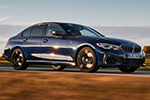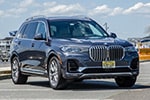Exclusive Interview with the Head of BMWNA Product Planning and Strategy/BMW Motorsport Manager, Martin Birkmann – A Look into the Future World of ///M Cars, Racing, and Current Engine Tech.
At the recent 2010 NAIAS, we got a chance to speak with Martin Birkmann who is the Head of Product Planning and Strategy with BMW NA, as well as BMW Motorsport Manager in the U.S. If you haven’t already, we advise you get some coffee brewing or pop-corn popping – what follows is extremely interesting information about current and future BMW products.
With BMW’s new engines, the revamped N54 and now the N55, what have you upgraded on the N54?
Martin Birkmann: With the N54 we’ve basically changed the mapping of the engine, pressure of the engine, given it a more sporty, more torquey, and peak oriented performance curve.
Martin Birkmann, left, Bobby Rahal, right, during the unveiling of the BMW M3 GT2 ALMS
What are the differences between the N54 and N55?
Martin Birkmann: At first glance we’ve changed something in the architecture, we made the engine more compact, but in terms of costumer benefit the biggest change is the application of VALVETRONIC. With variable valve lift we eliminate the throttle and so we’ve made the engine again more efficient than the N54. The N55 is maintaining the N54’s base performance level, but gives you a lot of enhancement on the efficiency side
Will we see the N55 engine across the range?
Martin Birkmann: We started announcing the N55 for the 5 series GT so you can expect to find it in the regular 5 series sedan, one series, and we’ll roll it out for more and more applications.
With the new 5 series, what kind of changes can we expect to see on the new M5?
Martin Birkmann: I think it’s been widely speculated and confirmed that we’ve somewhat seen the dawn of the end of the NA engine. M is no exception, we’ve launched our first turbo M engines and I think that will be the biggest difference if you look at the tech spec sheet – that we will go with turbo charging for the M5. There is speculation that I don’t want to comment about; we will clearly see a change in the transmission strategy, we are still examining the need for a second transmission variant. We’ll know more about that as we go forward, as you know, every one should know that BMW NA in persona is a big proponent of manual transmissions and three pedal vehicle operation, but it’s not a trend that you see in the market gaining a lot of momentum right now. Our customers want more semi-automatic transmissions, so that’s a must, and everything else is a can. We’ll see as we approach the launch of the car.
What clear future do you see for BMW and racing?
Martin Birkmann: ‘Racing’ and ‘clear future’ sounds almost oxymoronic, I think for the US market there’s a clear preference on the consumer side for production style racing, for tin top racing if you will. We’ve followed that through with the M3 program now going into the second season, and for the production run of the M3 – that’s a program that we hope to maintain with its car-presence. For us racing is about competition, it’s about aspiration, it’s about excitement and thrill. The grid that we find in the ALMS series just serves that perfectly. We have a great set of competitors that we respect and that we want to be respected by. We all do our utmost to earn their respect on the racetrack and that’s how I see racing for the US market. Formula 1 is a thing of the past now; we have to acknowledge that. We’ll see if that frees up ideas for other kinds of racing, but the statement I want to make for the US is production car racing.
With BMW doing so well in their return to ALMS, do you see any possibility of BMW entering LMP1 or LMP2 class racing?
Martin Birkmann: For us to go racing it needs to be relevant for our enthusiast fans, followers, supporters, and the best way to achieve that is with a road going version of the car. So we’ve started racing with the road car, it is not a silhouette racer, it is really a car that started its life off as an M3. With a prototype you lose some of that if you compare a prototype of type of brand x, y or z to each other; other than livery on the car it will be very difficult to associate a brand with them. That’s something that we addressed, we have had some great brand attributes such as the kidney grill on our last prototype car, but generally it is difficult because you follow the form of the prototype a lot more to the aerodynamic laws than you do with production cars. Again, production is the first priority of today.
What are the capabilities of DCT on M and non-M cars in terms of performance enhancement?
Martin Birkmann: You have the same basic 7 speed slush-box that is actuated with the double-clutch, you have a difference in cooling performance, rev-ability and then of course you also have an extra feature which is the drive logic in the M cars that allows you to change the characteristic of the gear changes.
With all of BMW’s experience in Formula 1, what lessons have been learned for the road cars and for technology to come forward?
Martin Birkmann: In the technology transfer between racing and road, I think the majority goes today from road to track. If you think of electronics, if you think of traction systems, brake systems, suspension systems, these are all things that we have a much broader data base on in our road cars, that our racing program can benefit from. The fact that we have, I don’t know how many million units in operation with stability control systems, and the ability to evolve those – allows us to make our race cars more efficient on the track and use the tires more efficiently. I think the technology transfer primarily goes from road to track, especially when you think about electronics. Lightweight componentry is something we experiment with on the racecars more. We have less cost inhibitions on the racing cars, that is something that we can possibly translate to the production cars going forward.
How does twin-scroll turbo technology compare to variable-vane turbo technology in terms of turbo lag and performance?
Martin Birkmann: Both of them can improve the response of the turbo engine. It depends on what your underlying engine architecture is. The benefit of the line up that we’re offering in the United States is that we’re offering a relatively large displacement so you clearly can say that the turbo is not used as a crutch to make a lame engine go, it’s a fantastic engine that you make go faster. That helps with the performance and the turbo lag. The engine electronics, the control of the VANOS in harmony with the VALVETRONIC (which improves the breathing), the twin-scroll and the variable-vane all contribute to reducing the lag. I don’t think you can rule out one of these technologies against another, they all contribute to make it better. Right now we use variable vanes only for small displacement engines in combination with twin scroll and we will apply it as we see necessary. I can tell you that the N55, in terms of linearity and response, yet increases the benchmark in terms of what a turbo engine can feel like.
What limits engine RPM on turbo motors and will it be possible to produce a high revving turbo for M applications?
Martin Birkmann: You don’t get the same benefit in terms of performance from a turbo as you get from a NA engine. The redline of our current turbo M engines is 7000rpm. Our first commercial M car was the M3, it had a redline of 7200 rpm, so I think that answers your question. We’re already high revving but the question is, what is the benefit that you see going up and up and up. One of the clear paths for the next generation M3 is to improve driveability and pickup out of every rev range and every gear especially in street legal speeds. The US market is the biggest M5 market, that’s not something that the V-10 has shown in the past.
Would it be possible to develop a diesel engine with M personality and drive characteristics?
Martin Birkmann: I think it’s a challenge. We started to be a bit more liberal with M engine configurations as of late. I think the field of high performance diesels is extremely intriguing. You will not get infinite levels of revs out of a diesel and you don’t need too, but I don’t see that this is something that can never happen. Right now we have a very different purchase motivation for our diesels cars than our gasoline cars. To me the bigger question is: is there a market there, is there a need there? We are looking into it.
Is it possible to develop higher revving diesel engines above 5000 rpm?
Martin Birkmann: Because it’s a self inducted engine you basically have a limit on how high you can rev them and that’s about 5000 rpm for all we know.
How low lag are the N54 and N55 turbo engines, and have BMW been able to successfully eliminate lag from their turbo engines?
You’ve driven a lot of BMW turbos, so that answer I give to you, but my answer is yes. We brag a lot and look a lot into middle seconds and response times and what not; you drive a conventional car, any motor, the response time from throttle input to arrival at the wheel is two tenths – so everything that you do to beat two tenths suffices to omit any kind of lag and we are way beyond that.
We would like to give our special thanks to BMW NA and Martin Birkmann for this enlightening interview.
BMWBLOG Editors, Josh Lewis and Shawn Molnar
The audio interview can be found below and in advance, we would like to apologize for the lower quality sound, the microphone “stalled” for a second.
[audio:BMWBLOG-Martin Birkmann Interview.mp3]



































































